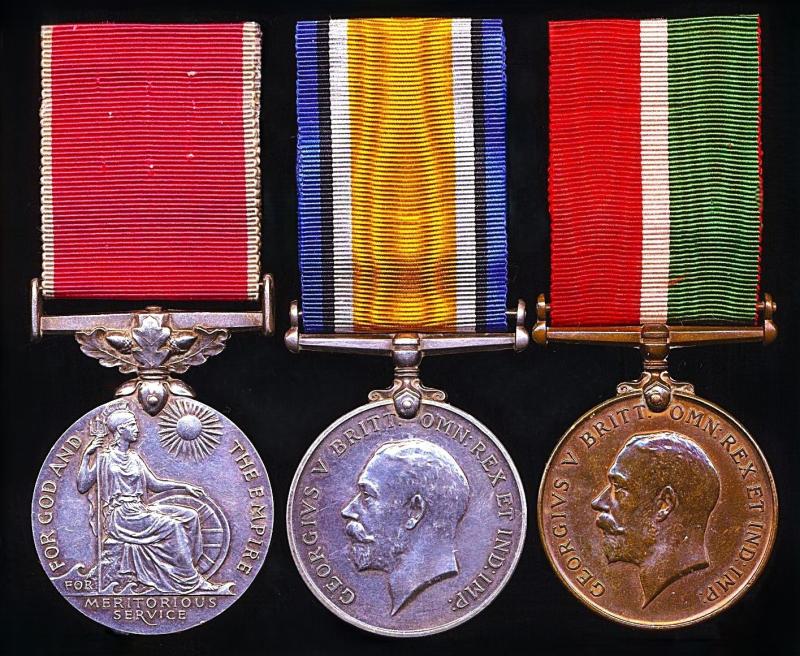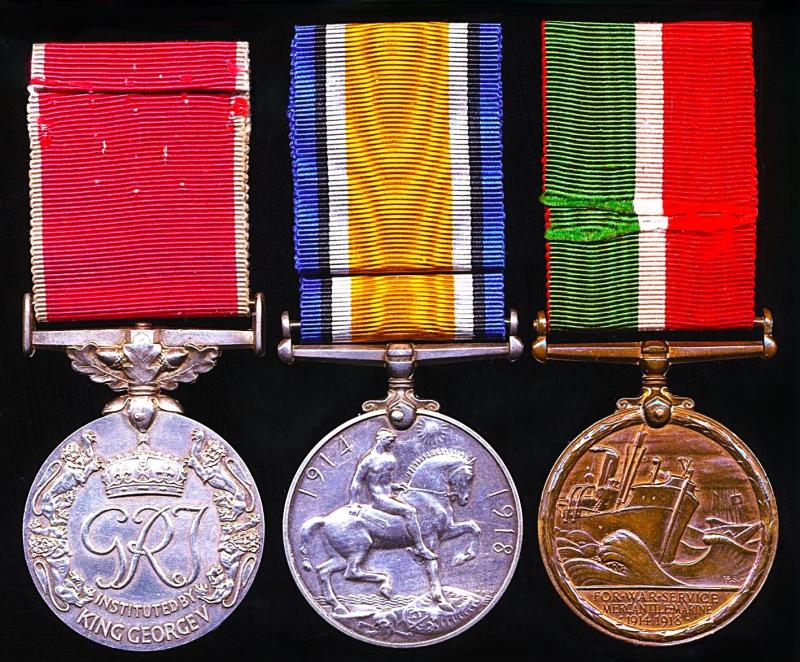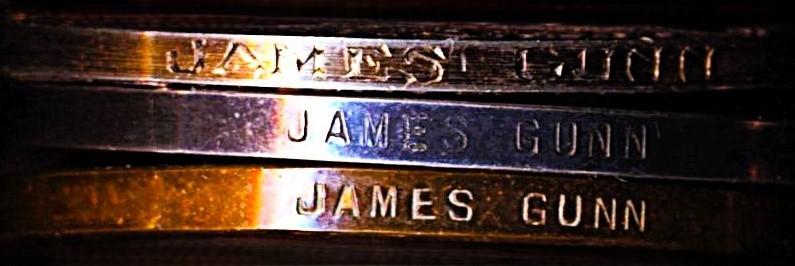A Shetland Islander From A Patriotic Family & Survivor of a Luftwaffe Aerial Torpedo Attack, World Wars Meritorious & Campaign Service Medal Group of 3: Boatswain James Gunn, late S.S. Cameronia
A well-documented Great War & WW2 Mercantile Marine B.E.M. Group of 3 awarded to Boatswain James Gunn, of the S.S. Cameronia, of the Anchor Line Shipping Company, Mercantile Marine, which was torpedoed by a JU.88 on 22 December 1942, comprising:
- British Empire Medal (Civil Division). GVI 1st Type (James Gunn)
- British War Medal. Silver issue (James Gunn)
- Mercantile Marine War Medal (James Gunn)
British Empire Medal: Published in London Gazette issue of 4 January 1943, and confirmed as an award while serving as Boatswain aboard S.S. 'Cameronia' (Seedie's List Of Awards To The Merchant Navy For World War II (Ripley Registers, 1997) refers
Photograph of Recipient in Uniform Wearing British Empire Medal: A fine captioned photograph of the recipient in uniform wearing his medal together with his youngest daughter, following the medal investiture, together with the below following article was published in the Shetland Times issue of 24 April 1943:
Quote,
THE KING GAVE HIM THE B.E.M.
Now home on leave is Merchant Navy Bo'sun James Gunn, 2 Cheyne Crescent, Lerwick, holder of the British Empire Medal, seen with his second daughter, Margaret after the investiture at Buckingham Palace at which he received his medal from the King.
With his B.E.M., he is wearing a last war service ribbon and the Merchant Navy ribbon.
He gained his latest decoration for meritorious service in Mediterranean waters after the fall of Greece and the evacuation of Crete. His ship was later torpedoed and beached on the North African coast. The captain was awarded the O.B.E.
Bo'sun Gunn has a twenty-seven years' record of service with the merchant service, twenty years of which he served with his present company, the famous Anchor Line.
His daughter Margaret is also engaged on war work, being employed in a munitions factory in the south-west of Scotland: an elder daughter and two young sons are at home. A brother is Mr. John Gunn, assistant engineer at Burnside Water Works and popular sergeant in Lerwick Company Home Guard.
Unquote.
Sold together with below original ephemera:
- Central Chancery Invitation Letter named & dated (19 March 1943) for recipient to attend B.E.M. award investiture at Buckingham Palace
- Ministry of War Transport Letter named & dated (28 December 1942) advising recipient of the B.E.M.
- Anchor Line Limited Letter named & dated (7 January 1943) congratulating recipient on the award of the B.E.M.
- General Register and Record Office of Shipping & Seamen medal transmittal slip named and dated (4 January 1984) for 5 x medals & 2 clasps 1939-45
Medals & Clasps Verification: All medals and below following clasps confirmed as awarded in respect of James Gunn(a confirmed unique name in both World Wars) full receipt of medal entitlement for both World Wars per the official London Gazette and Board of Trade sources cited below:
- British Empire Medal (Civil Division). GVI 1st Type: Published London Gazette issue of 4 January 1943
- British War Medal. Silver issue: BT 351/1/55672
- Mercantile Marine War Medal: BT 351/1/55672
- The 1939-1945 Star. No clasp: BT 395/1/38691
- The Atlantic Star. With clasp 'France and Germany': BT 395/1/38691
- The Africa Star. With clasp 'North Africa 1942-43': BT 395/1/38691
- The Italy Star: BT 395/1/38691
- The War Medal: BT 395/1/38691
James Gunn, a Scotsman and Shetland Islander, was born at Weathersta, Delting in the Shetlands on 22 June 1898, the son of Thomas Gunn, a crofter and fisherman
Having served in the Mercantile Marine during the Great War, James remained similarly employed between the wars and, on the renewal of hostilities in September 1939, he was employed as a Boatswain by the Anchor Line. He was awarded his British Empire Medal in respect of his services during the Luftwaffe aerial torpedo attacks while he was serving as serving on convoy duty aboard the troopship S.S. Cameronia.
The 'Anchor Line' S.S. Cameronia, made a dozen unescorted trips from Glasgow to New York in the period leading up to December 1940, when she was requisitioned as a troopship. Thereafter, she undertook several voyages to Sierra Leone and Cape Town, prior to assisting at the evacuation of Crete in May 1941.
But it was during her part in operations off Algeria, that she witnessed action of a memorable kind, being hit by a torpedo delivered by a Ju. 88 of KG 26 off Algiers on 22 December 1942. The resultant explosion killed 17 men and blew a massive hole in the ship's starboard side. A glimpse of those events is to be found on the BBC's 'People's War' website, via the diary of George Chadwick, one of Cameronia's stewards:
Quote,
'21 December 1942: We call at Algiers. Leave at about 9.30 p.m. Are warned to keep our guns manned as we may expect a torpedo attack from the air. 10.30 p.m. "Action Stations" sounded. We put up a terrific barrage from the ship.
22 December 1942: The "All Clear" is sounded at 1.30 a,m. We get a thankful rest until 4.00 a.m. when we have to go to "Action Stations" again. The planes seem very determined to get us as, all their attacks are concentrated solely on us. An aerial torpedo hits the ship on the starboard quarter. We proceed to our boats. I myself was amazed at the calmness displayed by the troops and it was a masterpiece of organisation considering there was over 4,000 souls on board. With relief we are told that the ship is in no immediate danger and with a powerful escort we limp back to a place called Bougie. So much for our short trip through what is known as "Suicide Alley". We have a few casualties, a few fatal. The catering department has to commence to salvage stores while the pumps keep the water at bay. We are successful on the above. The ship rapidly assumes normality even though there is a gaping hole in her side about 18' by 16'.
30 December 1942: We leave Bougie at 7 p.m. This is one of the most perilous voyages I have ever made. We still have a gaping hole in the ship's side and it's amazing the bulkhead on the opposite side does not give way with the pressure of water being hurled against it.
31 December 1942: This morning we bury at sea the last one of the soldiers who lost his life when the torpedo hit the ship. Ironically the remnants of the "tin fish" lie on the after deck for all to see. We have a very strong escort including fighter protection as we make our critical journey at just over 5 knots per hour. Our arrival in Algiers at 1 a.m. New Year's Day coincided with an air-raid warning but fortunately there was no activity. We had very dirty weather for the above short trip, which made it very dangerous to the ship.'
Unquote.
We may be sure that Gunn, in his capacity as Cameronia's Boatswain, was painfully aware of those dangers. Deservedly, he was subsequently decorated with the British Empire Medal in respect of his war services in the Mediterranean .
Boatswain James Gunn is believed to have remained with the Cameronia at-least until until mid-June 1944, seeing further active service off Italy and Normandy, France
James Gunn came from a patriotic Shetland family, that served with great distinction in both World Wars. His eldest brother Rifleman Joseph Thomas Gunn of the London Rifle Brigade was 'Killed-in-Action' at Ypres during the Great War. Another brother Captain James T. Gunn, O.B.E., D.S.C., a Merchant Navy captain was decorated in both World Wars, firstly gaining the D.S.C. during the Great War, and latterly with the O.B.E. for his services during the Second World War. Lastly brother John Gunn served as Sergeant-Major of No 2191 Company, No 2 Scottish Transport Column, Home Guard
James Gunn, B.E.M., lived to a ripe old age, dying at Lerwick in the Shetlands on 24 May 1996, at the age of 97
Condition: Medals GVF
Code: 24801






